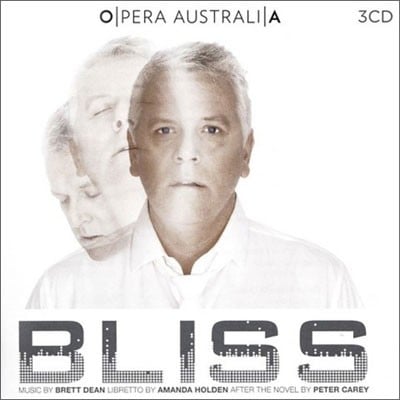Major roles: 3S,M,3T,2Bar,BBar; minor roles: 2S,T,Bar; dancers; chorus (up to 48 voices);
3(I,III=picc,II=afl).2(II=corA,whirly tube).3(II=bcl,III=bcl,dbcl).3(III=dbn)-4.2.2ttbn.btbn.1-timp(=sm tgl,lg cym).perc(3):I=vib/tam-t/crot(2octaves)/tamb/7cowbell/3tuned gong/sizzle.cym/Chin.cym/lion's roar/seed rattle; II=dr kit(SD/pedal BD/hi-hat/4tom-t/3bongo/susp.cym/sizzle.cym)/4wdbl/glsp/1tuned gong/whip/tam-t(sm)/whirly tube; III=marimba/BD/2tgl(lg,sm)/ratchet/rainmaker/2tuned gong/t.bells/glsp/vibraslap/bell tree/police whistle/duck call-harp-pft(=cel)-elec.git-MIDI kbd-strings(min.12.10.8.6.4, last desk players of vln1&2 also to play whirly tubes;
On-stage: cl, vln, git, upright piano; elec.vln
Abbreviations (PDF)
Bote & Bock
“The first standing ovation was for Peter Coleman-Wright’s warm, wry, beautifully sung performance in the role of Harry Joy, the advertising tycoon who descends into a modern Dante’s hell on realising the extent of his life’s dysfunctionality. The second was for composer Brett Dean and librettist Amanda Holden ... Bliss is a significant work and unusual in operatic terms for the amount of plot detail that Holden works into the narrative. The work holds the attention to the end, sustained by Dean’s wonderful score. To his well-known skills as an orchestral composer, Dean has added an under-utilised empathy for the voice. The sung lines drive the musical and dramatic pace, underscored by beautifully detailed instrumental textures, wrought with an innate feeling for the expressive power of instrumental timbre, watched over by counterpoint and fine motivic workmanship. Conductor Elgar Howarth realises these with precision and sensitivity.” (Peter McCallum, Sydney Morning Herald, 15 Mar 2010)
“At the end of Friday night’s world premiere of Bliss, after a long and involving performance in which all the components seamlessly worked as one, it was heartening to realise that, yes, here is an Australian opera so secure in form and purpose, it should, given care, live and flourish in all cultural climates for years. This is not to say it is necessarily an ‘easy’ work to understand. On the contrary, the technical and harmonic complexities of Brett Dean’s lyrical score, matched in words by Amanda Holden’s masterly distillation of Peter Carey’s original novel, demand much of an audience ... Carey’s story of Harry, the advertising executive who dies for nine minutes and returns to life only to find his family and professional existence a living hell, may have been written 30 years ago, but its message of the perils of materialism inherent in us all, still resound. The beauty of Neil Armfield’s focused, flowing production is how effortlessly yet meaningfully it propels us into Harry’s personal inferno ... Peter Coleman-Wright, as adroit an actor as he is singer, takes us from darkness to light with unerring brilliance of character and vocal assurance. It was as if he had been singing the role for years ... Brett Dean’s score pulses with energy and bristles with invention and clarity. There is special beauty, too, in the elegiac ending, as Harry and Honey sing rapturously of their simple and, indeed, blissful, world. In itself, Bliss can only add joy to the operatic firmament. Long may it live.” (Michael Shmith, The Age, 15 Mar 2010)
“The premiere of Bliss promised to be an important landmark in contemporary Australian classical music. In the foyer on opening night, politicians and media personalities rubbed shoulders with performing artists and prominent arts administrators. Many of Australia’s leading composers were in attendance to support their colleague ... A coalescence of Australian artistic talent has created a compelling opera. Bliss was performed with an assurance and confidence that is rare on any opening night. Although Dean and his librettist Amanda Holden considered Carey’s multi-layered novel an ideal operatic subject, I had my doubts. Dean and Holden confounded my scepticism. It is still recognisably Carey’s work but it has been successfully transferred into an operatic context ... Bliss also displays Dean’s mastery of orchestral colours. Bluesy muted trumpet and jazzy drum beats greet the arrival of the call-girl Honey Barbara. Disturbing tutti shrieks often accompany moments of high drama. But Dean employs his orchestration talents for higher purposes. Shades of light and dark match the emotions of the characters. Great care was taken to ensure the text was heard clearly over the multi-hued music. Neil Armfield’s direction, on the other hand, is based on an economy of means. Everything is focused on telling the story with clarity and precision ... Brian Thomson’s minimalist set was transformed into a series of resplendent settings with a colourful LED backdrop by lighting designer Nigel Levings. Used both literally and symbolically, this was imaginative and effective. The scenes were recognisably realistic yet also slightly surreal, just as in Carey’s novel. The role of Harry Joy was written specifically for baritone Peter Coleman-Wright. It was another triumph for this outstanding artist. Secure and supple across his range, he sang with burnished tonal warmth and resounding power ... Bliss is a success in every way and its short-term outlook is bright. A Melbourne season will follow the Sydney run and international productions have been announced.” (Murray Black, The Australian, 15 Mar 2010)

Peter Coleman-Wright / Merlyn Quaife / Lorina Gore / Barry Ryan / David Corcoran / Taryn Fiebig / Kanen Breen / Shane Lowrencev / Henry Choo / Milijana Nikolic
Opera Australia Chorus / Australian Opera and Ballet Orchestra / Elgar Howarth
Opera Australia CD 00289 481 1820 5

